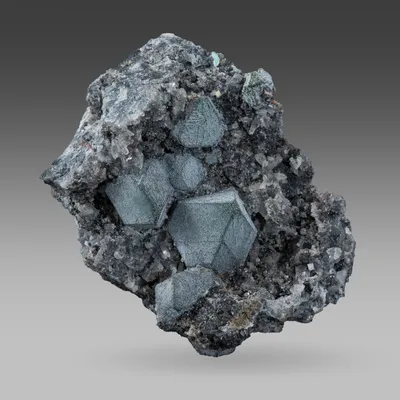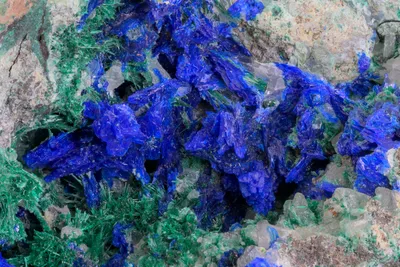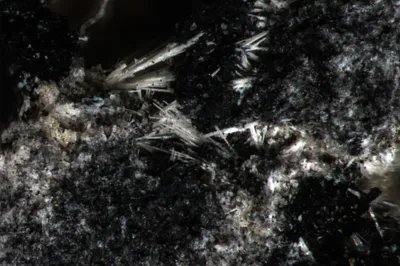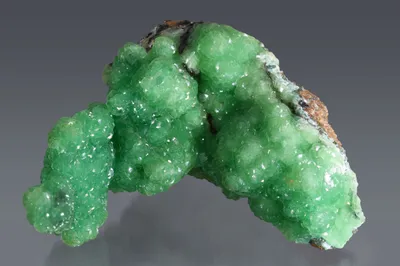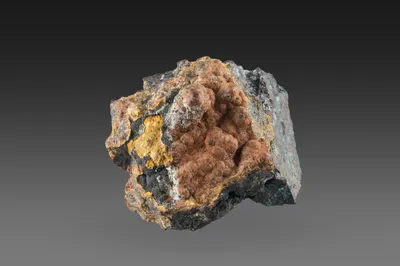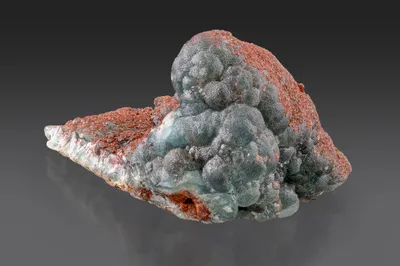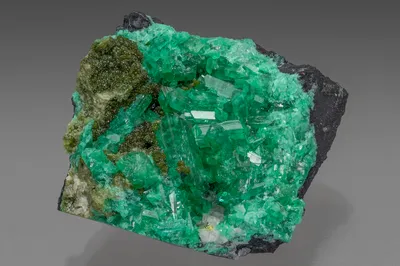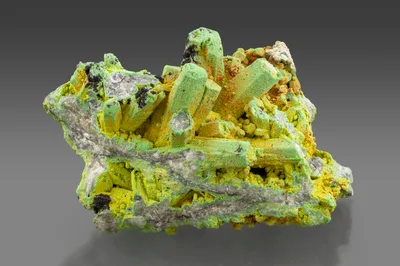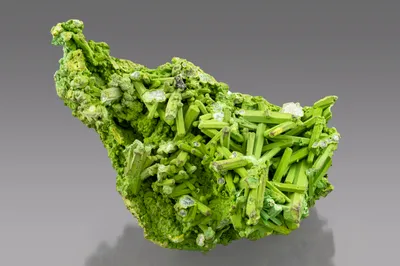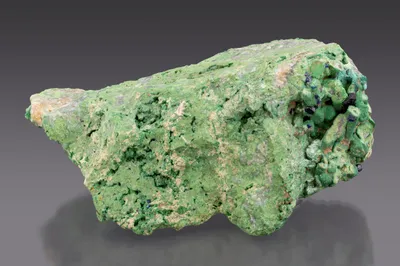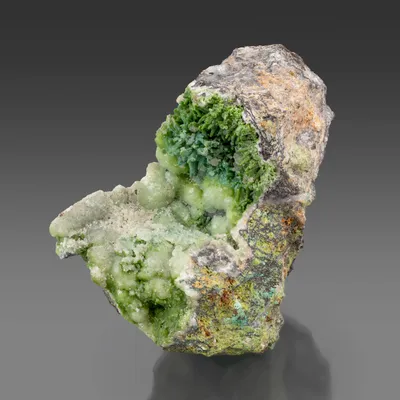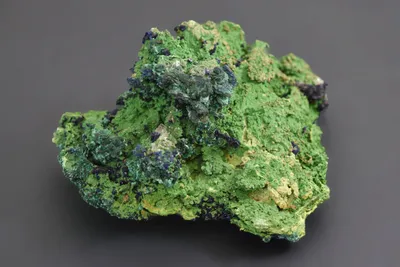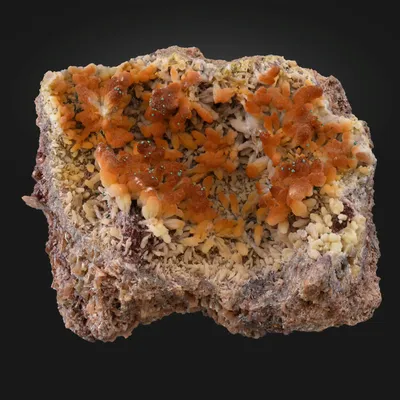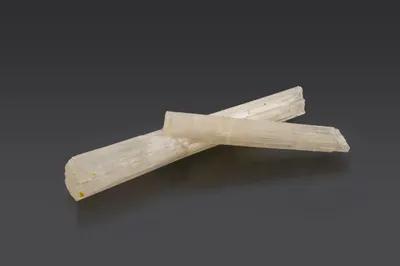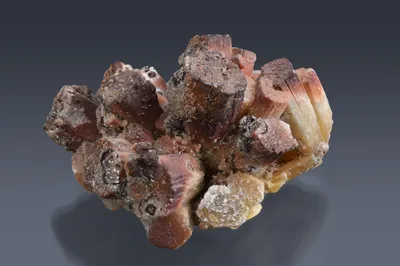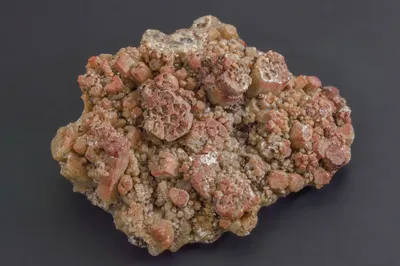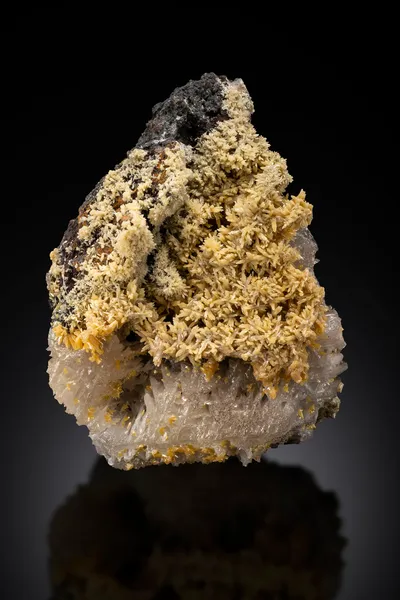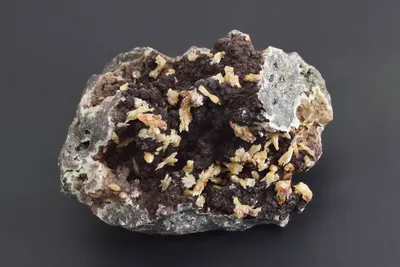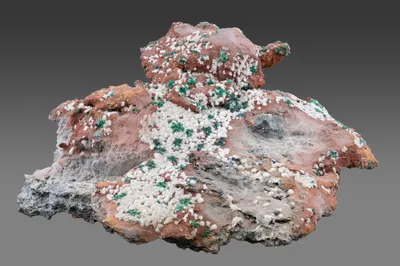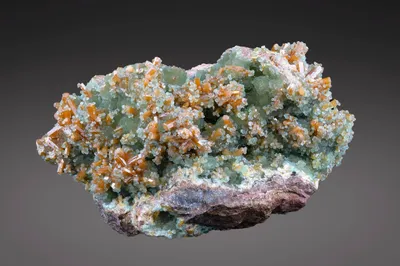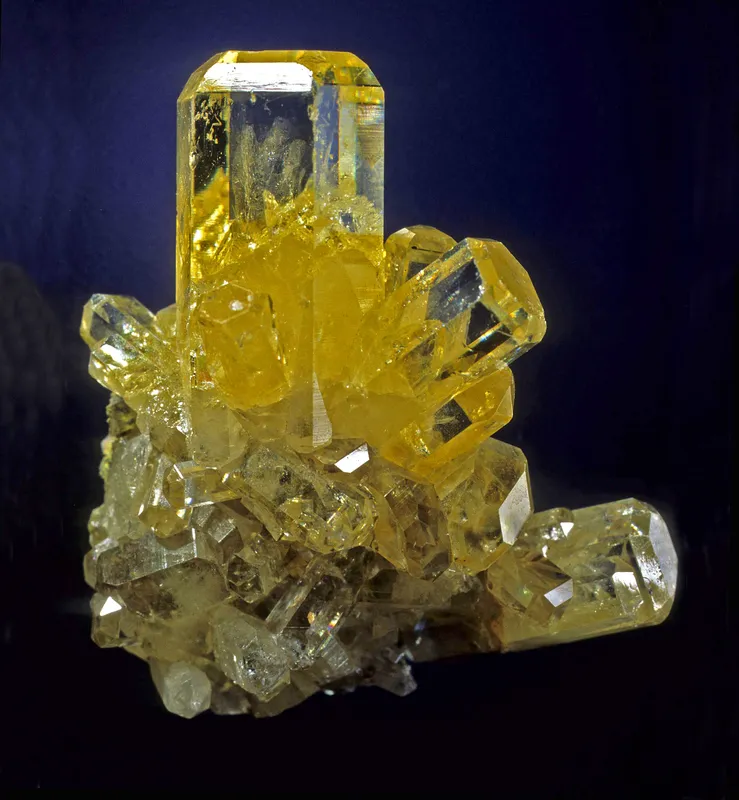
Image Credit: Cruce Cairncross
Mineral Species
Mimetite
Type Locality
No
Composition
Pb5(AsO4)3Cl
Crystal System
Hexagonal
Status at Tsumeb
Confirmed
Abundance
Common
Distribution
First, second and third oxidation zones
Paragenesis
Supergene
Entry Number
Species; TSNB241
General Notes
Mimetite occurs in all three oxidation zones at Tsumeb with an extraordinary range of colours, habits and associations. Cook (2001) considered Tsumeb the source of the world’s finest mimetite specimens in terms of "… crystal size, perfection and transparency".
The earliest list of Tsumeb minerals, published by Schneider (1906), made no mention of mimetite but it did include pyromorphite. The latter is an extremely rare mineral at Tsumeb and it seems almost certain that Schneider mistook mimetite, possibly encrusted with a green arsenate such as arsentsumebite, bayldonite or duftite, for pyromorphite. By contrast, Maucher (1908a) listed mimetite but not pyromorphite.
Biehl (1919) analysed specimens of mimetite from Tsumeb. For botryoidal mimetite he reported (Wt.%): PbO 70.96; FeO 0.81; As2O5 23.87; P2O5 0.57 Cl 2.73 while for transparent crystals he determined: PbO 66.77; CaO 2.81; As2O5 25.99; P2O5 1.98; Cl 2.32.
Pufahl (1920) described fresh crystals of mimetite from the upper part of the first oxidation zone (between the surface and 6 Level) as, "… prismatic in habit, up to 30 mm long and 15 mm thick, ranging from almost colourless, light grey with a yellowish tinge, translucent to completely milky and opaque. They often have a pale green copper-containing coating that is only loosely adherent." Others, up to 10 cm in length, are "… in the process of transformation to light green and yellowish-green bayldonite" and are either "completely changed or have a core of fresh [mimetite]". Pufahl’s (1920) analysis of mimetite gave: PbO – 67.31 wt %; As2O5 – 23.12 wt %; PbCl2 – 9.33 wt %.
Klein (1938) observed that mimetite was a common secondary mineral between surface and a depth of 300 m (i.e., from surface down to about 11 Level). He noted a diversity of habits and the occurrence of "beautiful crystals". Interestingly, all of the mimetite specimens in Klein’s collection are from levels 5, 8 and 9 (Klein Collection catalogue; unpublished, Klein family archive).
Pinch and Wilson (1977) noted that mimetite occurs at Tsumeb in a wide variety of colours, habits and associations. The colours range from nearly colourless, through white, pale yellow, lemon-yellow, pale brown, orange, red, grey, green and black. Individual crystals are always hexagonal and terminated with combinations of the pinacoid and/or various pyramids, but they vary in habit from minute acicular needles, to elongate prisms (exceptionally to 120 mm), stout prisms and tabular crystals, the latter habit being very rare. Composite crystals are common, presenting as cauliflower- or wheatsheaf-like aggregates, or as mammillary crusts.
The famous "Gem Pocket" was discovered in 1971 (Key 1977) and is believed to have been located at West 80 on 28 Level in the second oxidation zone. Key later recalled that the pocket produced several hundred specimens, many of them miniatures and thumbnails, but that there were perhaps 25 to 30 larger specimens of real significance (Southwood 2022d). The mimetite crystals are gemmy, transparent, very pale-yellow prisms, exceptionally to 65 mm in length, terminated by a pinacoid with a simple pyramidal bevel. The matrix for the Gem Pocket mimetites is dusted with powdery yellow gartrellite, which augments the colour of the mimetite. Transparent, gemmy mimetites of this size and quality are extremely rare and the specimens from this discovery are widely regarded as best of species (Cook 2001).
Keller and Bartelke (1982) recorded the discovery of "… brilliant black crystals of mimetite up to 1 cm tall … in an unusual intergrowth with reniform masses of hematite. A core of mimetite is overgrown by hematite which is partly or completely covered by a second generation of mimetite." The mimetite retains a euhedral habit with dominant prism and pyramid forms. Smithsonite and quartz are associated.
Keller and Bartelke (1982; citing a pers. comm. from John Innes) also made a fleeting reference to a discovery of mimetite in the North-East Stope of 35 Level. This find was made by Innes in the first weeks of 1980 and produced quite spectacular matrix-free, composite prisms of translucent, ivory-white to pale yellow coloured mimetite to 75 mm. An example from this discovery is in the collections at Harvard University (MGMH 126262) with a pair of conjoined crystals to 52 mm; no other minerals are present.
Gebhard (1999) reported the 1995 discovery of a 12 cm doubly terminated pencil-like crystal of yellow mimetite and the occurrence of white bipyramidal mimetite crystals resembling witherite. He also mentions bipyramidal crystals of Ca-rich mimetite, 1 cm across on a white calcite matrix. These Ca-rich mimetites are intermediate in composition between mimetite and hedyphane.
Mimetite occurs in association with a diverse list of other minerals and is found in small amounts in a wide range of parageneses. Keller (1977a) included mimetite in three of his "Type I" parageneses (i.e., mineral sequences forming at relatively high pH ranges):
I/3: cerussite >> (duftite(i) + malachite) >> mimetite >> cerussite >> duftite(ii)
I/4: goethite >> wulfenite >> mimetite >> malachite
I/6: (willemite(i) + smithsonite(i)) >> (mimetite or (rosasite + duftite) >> willemite(ii) >> cerussite >> smithsonite(ii)
Mimetite is reported as a component of the type assemblages for the following minerals: arsendescloizite (Keller and Dunn 1982a); fleischerite (Frondel and Strunz 1960); gebhardite (Medenbach et al. 1983b); itoite (Frondel and Strunz 1960); kegelite (Medenbach and Schmetzer 1986); mathewrogersite (Keller and Dunn 1986); plumboselite (Kampf et al. 2011); schultenite (Spencer and Mountain 1926) and tsumcorite (Geier et al. 1971). The mimetite of tabular habit included in the thometzekite type assemblage (Schmetzer et al. 1985) was later shown to be vanackerite (Schlüter et al. 2012).
The monoclinic polytype of mimetite (formerly clinomimetite) has not been reported from Tsumeb.
Spectacular pseudomorphs in which mimetite crystals (to 50 mm) are partly or wholly replaced by lead-copper arsenates, were abundant in the upper part of the first oxidation zone, mainly from between the surface and 5 Level. In the early years of mining these were usually labelled as "bayldonite after mimetite"; in many cases, however, the mimetite is replaced by arsentsumebite, or a mixture of bayldonite and arsentsumebite, and replacements by duftite have also been recorded (Southwood 2022b).
Mimetite forms partial and complete pseudomorphs after cerussite (Cairncross 2021) in which the cerussite has been partly or wholly replaced by a network of tiny and closely intergrown acicular mimetite crystals.
Associated Minerals
adamite; anglesite; aragonite; arsendescloizite; arsenopyrite (?); arsentsumebite; arthurite (?); azurite; bayldonite; beaverite-(Cu); beudantite; calcite; cerussite; conichalcite; copper; corkite; cuprite; dioptase; dolomite; duftite; feinglosite; fleischerite; fluorite; fraipontite; galena; gartrellite; gebhardite; goethite; gypsum; hedyphane; hematite; hemimorphite; hydrocerussite; hydroxylpyromorphite; itoite (?); kasolite; kegelite; langite; larsenite; leadhillite; linarite; malachite; mathewrogersite; melanotekite; mottramite; munakataite; phosgenite; plattnerite (?); plumbojarosite; plumboselite; posnjakite; quartz; queitite; rosasite; schultenite; senarmontite; sidpietersite; smithsonite; sulphur; tennantite-(Zn); tsumcorite; vaterite; willemite; wulfenite; zharchikhite; zincolivenite
Pseudomorphs
Mimetite is reported to form pseudomorphs after the following minerals: cerussite (rare).
The following minerals are reported to form pseudomorphs after mimetite: arsendescloizite (rare); arsentsumebite (common); bayldonite (common); calcite (rare); cerussite (rare); duftite (rare); hedyphane (rare); tsumebite (rare, dubious, probably arsentsumebite); willemite (rare).


